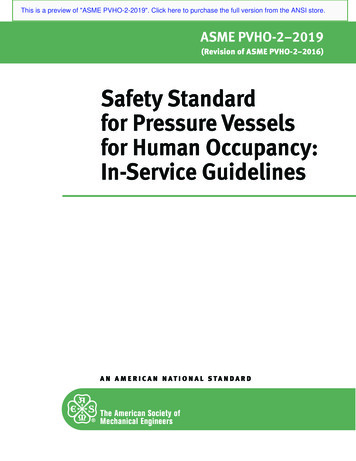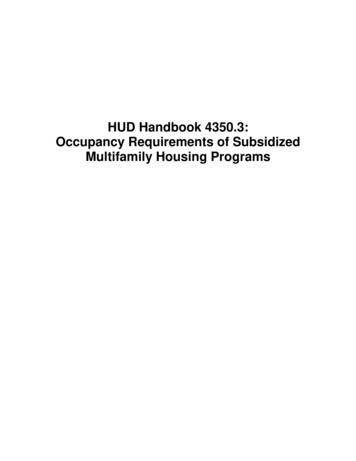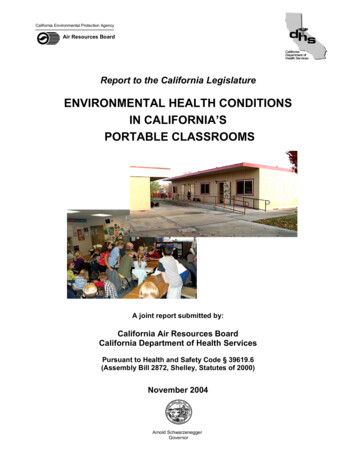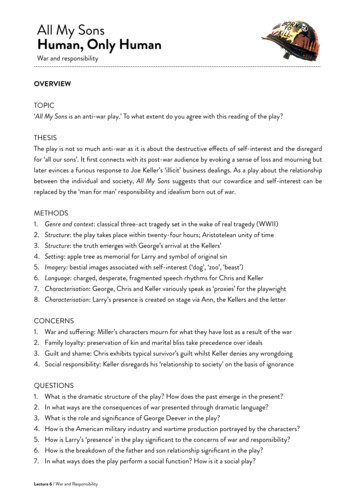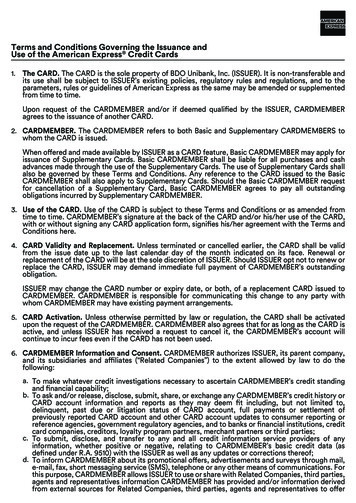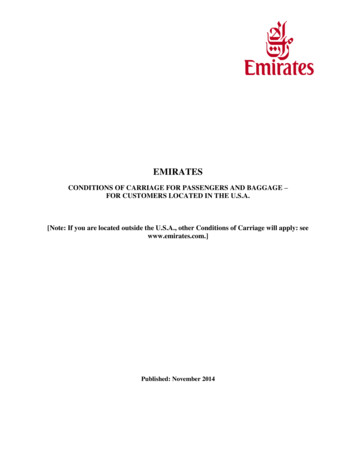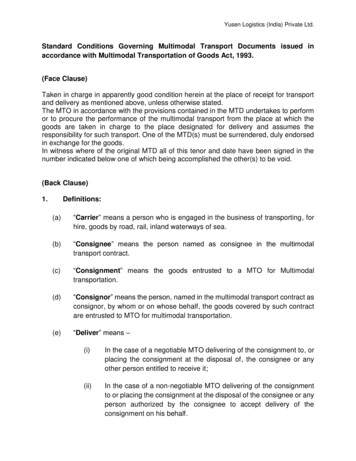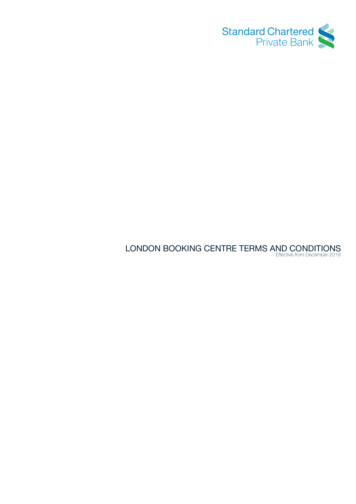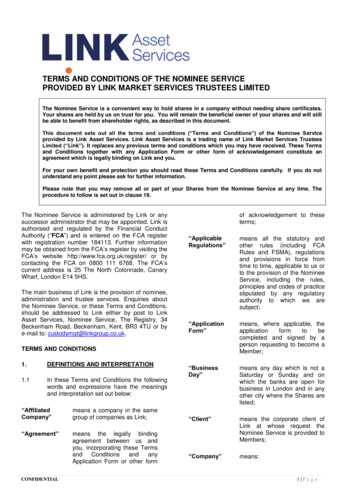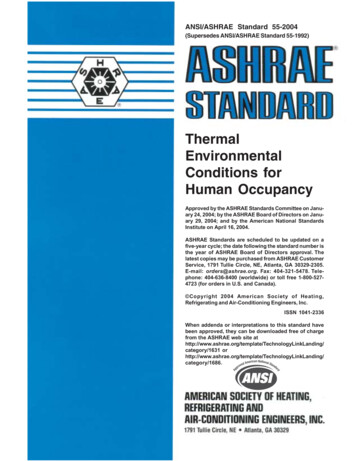
Transcription
ANSI/ASHRAE Standard 55-2004(Supersedes ANSI/ASHRAE Standard 55-1992)ThermalEnvironmentalConditions forHuman OccupancyApproved by the ASHRAE Standards Committee on January 24, 2004; by the ASHRAE Board of Directors on January 29, 2004; and by the American National StandardsInstitute on April 16, 2004.ASHRAE Standards are scheduled to be updated on afive-year cycle; the date following the standard number isthe year of ASHRAE Board of Directors approval. Thelatest copies may be purchased from ASHRAE CustomerService, 1791 Tullie Circle, NE, Atlanta, GA 30329-2305.E-mail: orders@ashrae.org. Fax: 404-321-5478. Telephone: 404-636-8400 (worldwide) or toll free 1-800-5274723 (for orders in U.S. and Canada). Copyright 2004 American Society of Heating,Refrigerating and Air-Conditioning Engineers, Inc.ISSN 1041-2336When addenda or interpretations to this standard havebeen approved, they can be downloaded free of chargefrom the ASHRAE web site ding/category/1631 ding/category/1686.
ASHRAE Standard Project Committee 55Cognizant TC: TC 2.1, Physiology and Human EnvironmentSPLS Liaison: Frank E. JakobWayne A. Dunn, Chair*Gail S. Brager, Vice-Chair*Gaetano AlfanoLarry G. BerglundKarl A. BrownDaniel R. ClarkJoseph J. Deringer*Clifford C. FederspielJaap J. HogelingDaniel Int-Hout, III* (Chair, 1999-2001)Byron W. JonesJoseph N. KnappAlison G. Kwok*Hal Levin*Arsen K. MelikovBjarne W. Olesen* (Chair, 1995-1998)Nigel A. OselandNicholas B. Rajkovich*Gary RawDavid G. Scheatzle*Dipak J. ShahPeter Simmonds*Jerry M. Sipes*Elia M. Sterling*Benjamin P. Sun*Steven T. Taylor*Shin-Ichi TanabeRobert W. Tinsley*Jorn Toftum*Stephen C. Turner*James E. Woods*Denotes members of voting status when the document was approved for publicationASHRAE STANDARDS COMMITTEE 2003-2004Frank E. JakobStephen D. KennedyDavid E. KnebelFrederick H. KohlossMerle F. McBrideMark P. ModeraCyrus H. NasseriGideon ShavitDavid R. TreeThomas H. WilliamsJames E. WoodsRoss D. Montgomery, BOD ExOKent W. Peterson, COVan D. Baxter, ChairDavor Novosel, Vice-ChairDonald B. BivensDean S. BorgesPaul W. CabotCharles W. Coward, Jr.Hugh F. CrowtherBrian P. DoughertyHakim ElmahdyMatt R. HarganRichard D. HermansJohn F. HoganClaire B. Ramspeck, Manager of StandardsSPECIAL NOTEThis American National Standard (ANS) is a national voluntary consensus standard developed under the auspices of the AmericanSociety of Heating, Refrigerating and Air-Conditioning Engineers (ASHRAE). Consensus is defined by the American National StandardsInstitute (ANSI), of which ASHRAE is a member and which has approved this standard as an ANS, as “substantial agreement reachedby directly and materially affected interest categories. This signifies the concurrence of more than a simple majority, but not necessarilyunanimity. Consensus requires that all views and objections be considered, and that an effort be made toward their resolution.”Compliance with this standard is voluntary until and unless a legal jurisdiction makes compliance mandatory through legislation.ASHRAE obtains consensus through participation of its national and international members, associated societies, and publicreview.ASHRAE Standards are prepared by a Project Committee appointed specifically for the purpose of writing the Standard. TheProject Committee Chair and Vice-Chair must be members of ASHRAE; while other committee members may or may not be ASHRAEmembers, all must be technically qualified in the subject area of the Standard. Every effort is made to balance the concerned interestson all Project Committees.The Manager of Standards of ASHRAE should be contacted for:a. interpretation of the contents of this Standard,b. participation in the next review of the Standard,c. offering constructive criticism for improving the Standard,d. permission to reprint portions of the Standard.DISCLAIMERASHRAE uses its best efforts to promulgate Standards and Guidelines for the benefit of the public in light of availableinformation and accepted industry practices. However, ASHRAE does not guarantee, certify, or assure the safety orperformance of any products, components, or systems tested, installed, or operated in accordance with ASHRAE’s Standardsor Guidelines or that any tests conducted under its Standards or Guidelines will be nonhazardous or free from risk.ASHRAE INDUSTRIAL ADVERTISING POLICY ON STANDARDSASHRAE Standards and Guidelines are established to assist industry and the public by offering a uniform method oftesting for rating purposes, by suggesting safe practices in designing and installing equipment, by providing proper definitionsof this equipment, and by providing other information that may serve to guide the industry. The creation of ASHRAE Standardsand Guidelines is determined by the need for them, and conformance to them is completely voluntary.In referring to this Standard or Guideline and in marking of equipment and in advertising, no claim shall be made, eitherstated or implied, that the product has been approved by ASHRAE.
CONTENTSANSI/ASHRAE Standard 55-2004Thermal Environmental Conditions for Human OccupancySECTIONPAGEForeword . 21 Purpose . 22 Scope . 23 Definitions. 24 General Requirements . 35 Conditions that Provide Thermal Comfort . 46 Compliance. 117 Evaluation of the Thermal Environment . 128 References . 14Normative Appendix A: Activity Levels. 15Normative Appendix B: Clothing Insulation. 16Informative Appendix C: Acceptable Approximation for Operative Temperature . 20Normative Appendix D: Computer Program for Calculation of PMV-PPD . 21Informative Appendix E: Thermal Environment Survey. 23Informative Appendix F: Bibliography . 25 Copyright 2004 American Society of Heating,Refrigerating and Air-Conditioning Engineers, Inc.1791 Tullie Circle NEAtlanta, GA 30329www.ashrae.orgAll rights reserved.
(This foreword is not part of this standard. It is merelyinformative and does not contain requirements necessaryfor conformance to the standard. It has not been processed according to the ANSI requirements for a standard and may contain material that has not been subjectto public review or a consensus process.)FOREWORDStandard 55-2004, “Thermal Environmental Conditionsfor Human Occupancy,” is a revision of Standard 55-1992.The standard specifies conditions in which a specified fractionof the occupants will find the environment thermally acceptable. The revision is a consensus standard that has undergonepublic and ASHRAE review; it incorporates the relevantresearch and experience gained since the 1992 revision. Suchchanges include the addition of the PMV/PPD calculationmethods and the concept of adaptation. The standard isintended for use in design, commissioning, and testing ofbuildings and other occupied spaces and their HVAC systemsand for the evaluation of thermal environments. Because it isnot possible to prescribe the metabolic rate of occupants, andbecause of variations in occupant clothing levels, operatingsetpoints for buildings cannot be practically mandated by thisstandard.The designer may choose, in agreement with the owner orowner’s representative (e.g., owner’s agent, developer, orequivalent), the level of thermal comfort and appropriateexceedance. The selected design criteria will influence theHVAC system design and may also influence the buildingdesign. This standard may also be used for evaluation of existing thermal environments in buildings, during experimentalconditions, and for the development and testing of products.This standard is in close agreement with ISO Standards77261 and 7730.21. PURPOSEThe purpose of this standard is to specify the combinations of indoor thermal environmental factors and personalfactors that will produce thermal environmental conditionsacceptable to a majority of the occupants within the space.2. SCOPE2.1 The environmental factors addressed in this standard aretemperature, thermal radiation, humidity, and air speed; thepersonal factors are those of activity and clothing.2.2 It is intended that all of the criteria in this standard beapplied together since comfort in the indoor environment iscomplex and responds to the interaction of all of the factorsthat are addressed.2.3 This standard specifies thermal environmental conditions acceptable for healthy adults at atmospheric pressureequivalent to altitudes up to 3000 m (10,000 ft) in indoorspaces designed for human occupancy for periods not lessthan 15 minutes.2.4 This standard does not address such nonthermal environmental factors as air quality, acoustics, and illumination orother physical, chemical, or biological space contaminantsthat may affect comfort or health.23. DEFINITIONSadaptive model: a model that relates indoor design temperatures or acceptable temperature ranges to outdoor meteorological or climatalogical parameters.air speed: the rate of air movement at a point, without regardto direction.clo: a unit used to express the thermal insulation provided bygarments and clothing ensembles, where 1 clo 0.155 m2 C/W (0.88 ft2·h· F/Btu).comfort, thermal: that condition of mind which expressessatisfaction with the thermal environment and is assessed bysubjective evaluation.draft: the unwanted local cooling of the body caused by airmovement.draft rate (DR): percentage of people predicted to be dissatisfied due to draft.environment, thermal: the characteristics of the environmentthat affect a person's heat loss.environment, acceptable thermal: an environment that asubstantial majority of the occupants would find thermallyacceptable.garment: a single piece of clothing.humidity ratio: the ratio of the mass of water vapor to the massof dry air in a given volume.humidity, relative (RH): the ratio of the partial pressure (ordensity) of the water vapor in the air to the saturation pressure(or density) of water vapor at the same temperature and thesame total pressure.insulation, clothing/ensemble (Icl ): the resistance to sensibleheat transfer provided by a clothing ensemble. Expressed inclo units. Note: The definition of clothing insulation relates toheat transfer from the whole body and, thus, also includes theuncovered parts of the body, such as head and hands.insulation, garment (Iclu ): the increased resistance to sensible heat transfer obtained from adding an individual garmentover the nude body. Expressed in clo units.met: a unit used to describe the energy generated inside thebody due to metabolic activity, defined as 58.2 W/m2 (18.4Btu/h·ft2), which is equal to the energy produced per unitsurface area of an average person, seated at rest. The surfacearea of an average person is 1.8 m2 (19 ft2).metabolic rate (M): the rate of transformation of chemicalenergy into heat and mechanical work by metabolic activitieswithin an organism, usually expressed in terms of unit area ofthe total body surface. In this standard, this rate is expressedin met units.ANSI/ASHRAE STANDARD 55-2004
naturally conditioned spaces, occupant controlled: thosespaces where the thermal conditions of the space are regulatedprimarily by the opening and closing of windows by the occupants.temperature, plane radiant (tpr ): the uniform temperature ofan enclosure in which the incident radiant flux on one side ofa small plane element is the same as in the existing environment.neutrality, thermal: the indoor thermal index value corresponding with a mean vote of neutral on the thermal sensationscale.time constant: the time for a measuring sensor to reach 63%of the final value after a step change.percent dissatisfied (PD): percentage of people predicted tobe dissatisfied due to local discomfort.turbulence intensity (Tu): the ratio of the standard deviation of the air speed (SDv) to the mean air speed (v). Turbulence intensity may also be expressed in percent (i.e., Tu [SDv / va] · 100).predicted mean vote (PMV): an index that predicts the meanvalue of the votes of a large group of persons on the sevenpoint thermal sensation scale.predicted percentage of dissatisfied (PPD): an index thatestablishes a quantitative prediction of the percentage of thermally dissatisfied people determined from PMV.radiant temperature asymmetry: the difference between theplane ra
ANSI/ASHRAE STANDARD 55-2004 3 naturally conditioned spaces, occupant controlled: those spaces where the thermal conditio ns of the space are regulated primarily by the opening and closing of windows by the occu-pants. neutrality, thermal: the indoor thermal index value corre-sponding with a mean vote of neutral on the thermal sensation scale. percent dissatisfied (PD): percentage of people .
